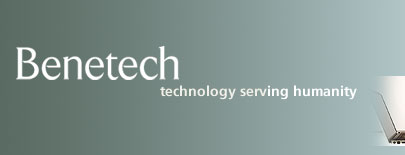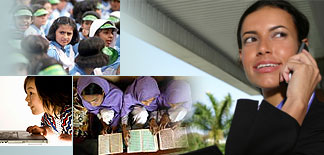
Jim Fruchterman |
February 2005
Benetech’s growth curve is an exciting challenge for our team. Our core enterprises are growing as we add a handful of new projects. We’re delighted about the support we have gotten from venture philanthropists as well as more traditional funders, because it’s making so many new things possible. Personally, my 2005 will be all about raising capital so that the general managers of each of our projects can focus on building their enterprises. Here’s a brief update on 2004 and what’s ahead for 2005 in:
- Our three major enterprises
- Our three new, partially funded projects
- Our dream projects
- The BeneBlog and more about Benetech
- Other Benetech updates
Bookshare.org
We are delighted that Janice Carter has just joined our team as our new Director of Literacy Programs, and heads Bookshare.org. Janice comes to us with a strong background in media and technology management, with more than twenty years of executive and entrepreneurial leadership. She has the vision, experience, and can-do attitude necessary to accomplish Benetech’s goals in global literacy.
Bookshare.org continues to grow: we just passed the 20,000 book mark this month. It’s easy to see the latest books we have on Bookshare.org, by checking out the new books link http://www.bookshare.org/web/BooksNew.html. We’ve added newspapers and magazines thanks to working with the Newsline service of the National Federation of the Blind. We have partnered with the Tiflolibros nonprofit organization in Argentina to bring over 1,000 books in Spanish to Bookshare.org in 2005. And, we’re continuing to expand our efforts in the education field with more partnerships with universities, more than fifty adopted textbooks in California, and extensive work on core reading lists for students.
Bookshare.org is also well positioned as the digital book world is taking off. The huge library announcement by Google has created a great deal of excitement about accessibility applications of this content. Our reputation for technical excellence and integrity with publishers and authors should enable us to be a key part of the solution here!
Martus
We released Martus version 2.5 in November, which responded to user requests and has made Martus into a flexible tool for collecting information on human rights abuses. We have made multiple trips to Africa and Asia to train users on Martus and we continue to see steady growth in users, downloads and bulletins.
Our work in Africa is assisting nongovernmental organizations (NGOs) in Algeria, Egypt, Nigeria and Kenya to monitor social justice abuses. Part of our work to reach out to these groups is translating Martus into Arabic – an exciting challenge for our team. Additionally, we have identified the Citizen’s Coalition for Constitutional Change, a local Kenyan NGO, to host a Martus server for use by activists adopting Martus throughout Africa so that these groups can protect sensitive information in a secure environment. Other places in Africa where NGOs are actively using Martus include Somalia and Sierra Leone.
In Asia, we are partnering with the Asia Foundation to help NGOs monitor abuses in Cambodia, Nepal and Thailand. To serve this region, we have translated Martus into Khmer, Nepali and Thai. Strategic planning and needs assessment for this project began in 2004 and training will commence in 2005.
There is interest in using Martus closer to home. Our very own Marc Levine, Senior Product Manager of the Martus Project, was selected by the Community Technology Foundation of California as a ZeroDivide Fellow in 2004. This fellowship works to bring technology to underserved community-based nonprofits in California. This is a great acknowledgement of our work as we look to support nonprofits in the United States with their information management needs as we do with organizations abroad.
The Human Rights Data Analysis Group (HRDAG)
HRDAG has had a big year, with major projects in Sierra Leone and East Timor. Patrick Ball likes to say that the goal of HRDAG is to turn information into knowledge and understanding.
In Sierra Leone, we assisted the Truth and Reconciliation Commission by managing and cleaning their database built from more than 7000 narrative statements, conducting statistical analysis, and writing the statistical chapter of their report. We will publish the statistical chapter of the TRC report, and the statistical database from the TRC, on the Benetech website in the first quarter of 2005.
In East Timor, we assisted the Commission for Truth, Reception, and Reconciliation (CAVR) to conduct a retrospective mortality survey of 1400 randomly selected households, and we helped with a census of over 327,000 gravestones. With the 8000 narrative statements taken by the Commission, these data sources show the patterns of mortality in the late 1970s as the Indonesians consolidated their occupation of the island. The CAVR will publish their report in June, 2005.
At the same time, we continued development on Analyzer, our "who did what to whom" statistical database. With the support of the Open Society Institute, we connected Analyzer to Martus so that bulletins can be imported as text sources for statistical processing, and we completed the internationalization capability so that Analyzer runs in multiple languages.
New Projects
The Landmine Detector Project
Ted Driscoll has spent the second half of 2004 doing market research, developing the business and product plans, recruiting key staff, and creating fundraising documents for our Landmine Detector project. He spent a month in Southeast Asia working directly with groups removing landmines and unexploded ordnance (UXO). He confirmed that a mine detector that actually detected buried explosives rather than just the metal housing would be invaluable in demining operations. We also heard of a requirement for large area mine detection, a macro-detector that would tell you whether there were any mines in a large area, to complement existing micro-detectors (is there a mine four inches under the surface right here). Ted’s recruited a top advisory team to help us with the technical challenges that includes Arno Penzias (Nobel Laureate), Armand Neukermans, Sheldon Breiner, Robert Gard (US Army, ret.), Mark Horowitz and Geoff Barrall.
ALL-Link Literacy Project
We worked up a business plan for ALL-Link and 2004 and are currently seeking funding to carry us through the launch of ALL-Link as an enterprise. ALL-Link teaches reading to teenagers and adults who have fallen through the cracks of the system. The underlying technology and concepts were developed by Prof. Karen Erickson’s team and UNC Chapel Hill, and we’re excited about bringing it out as a social enterprise in 2005.
Environmental Project
We have often thought about applications of Benetech-style technology in the environmental sector. We are delighted to be working with the Conservation Measures Partnership, a coalition of the leading conservation groups (Wildlife Conservation Society, the Nature Conservancy, World Wildlife Fund, Conservation International, etc.) to develop software to help practitioners design, manage, and monitor their projects. Our project is at an early stage, but it’s great to be collaborating with experts in this field to explore how technology can make conservation efforts more effective.
Dream Projects
There are so many more exciting projects than we can tackle with our current staff and resources. We are especially excited about the potential of the cell phone as a platform for socially exciting technology. Here are some of the dream cell phone projects that we would tackle if our core projects were fully funded and we had the additional support to take these new ideas on:
- ReadingCam. Turning a standard cell phone into a reading machine for the print disabled and illiterate.
- NaviTalker. One of our early patents was on a talking GPS device for the disabled. We have a corporate partner who has already developed a prototype based on a standard cell phone.
- The cell phone reader. If you want to deliver books around the world to people so that they can afford them, they need to be priced at 99 cents. How do you do that? Use the cell phone as a delivery platform!
- Martus on a cell phone. With cameras and built-in
GPS, cell phones become an incredible platform for gathering social
justice information. We just need a few more pieces to collect such
information and provide some measure of protection to those gathering
it.
The BeneBlog and more about Benetech
You can learn more about Benetech by reading the Beneblog: this is my roughly weekly blog on the latest happenings at Benetech and my travels in the social entrepreneurship field. One of the privileges of my job is being able to talk to top business, government and nonprofit leaders about technology in the service of society, and I talk about these in my blog. You can subscribe to get the BeneBlog by email as well as checking out the latest on our homepage.
Other Benetech updates
- The Benetech Fellow Program. We finished our first year-long Fellow Program in 2004 and are renewing it for 2005. The goal of the Fellow Program is to provide opportunities for mid-career professionals in business and technology to spend 9 to 12 months on a Benetech project and try out the intersection of technology and the social sector. Two of our 2004 Fellows have joined Benetech as regular employees: Anna Berns as Martus Product Manager and Gerry Sinzdak as Business Development Project Manager. We are very happy about how this program has served its objectives, and Betty DeLuco has joined as a Fellow working on Bookshare.org, bringing her considerable experience in software development to bear on improving book access. We are also recruiting for a Martus/Human Rights Engineering Fellow as I write this.
- Getting around. I have had some incredible trips related to our work. The two that come to mind were opportunities I received through the Schwab Foundation for Social Entrepreneurship: the Africa Economic Summit in Mozambique and the Social Entrepreneurship Summit in Brazil. Visiting social entrepreneurs on their home territory and meeting their teams is invaluable to me as I think about what we should be doing in the future. I’ve also been invited back to the World Economic Forum in Davos for a third year, a pleasant surprise since the Schwab Fellowship only promised two visits.
- Our BookAccess Project in Iraq has been moving
forward steadily: access to digital books and journals is increasing.
We have been writing software, scanning medical, dental and nursing
textbooks as well as buying hardcopy books for the libraries of the
University of Mosul. We would like Mosul to have the kind of access
to books that a typical American university enjoys.
Conclusion
Our ability to make change in the world depends on our ability to marshal resources. Because of the leverage of technology ventures (the same leverage that makes software entrepreneurs so wealthy), we have terrific opportunities for impact with modest investments. The Benetech model depends on access to three critical resources:
- People: the finest of the tech sector’s professionals, motivated to make a positive impact on society first and foremost
- Technology and intellectual property: Benetech fills in the market failure gap in the application of IP to critical social problems, but depends on IP owners to license us their assets to apply in these socially beneficial ways
- Money: even though we’re tight, technology ventures cost money to get off the ground. We can bring a new venture to market for somewhere between $500 thousand and $2.5 million: inexpensive by Valley standards but still a formidable sum to raise.
If you can personally help with any of these three resources, let me know. It’s my job to make the case why Benetech is the most powerful place to employ these scarce resources to benefit humanity.
Jim Fruchterman
President and CEO, The Benetech Initiative
Email: [email protected]

